Robert Roberts in North America
Few know that Robert Roberts, the first Editor of The Christadelphian, and the source of much of our original literature, was on the continent seven times from 1871 to 1898. He crisscrossed west to east, north to Nova Scotia, and south to Virginia.
 Read Time: 18 minutes
Read Time: 18 minutes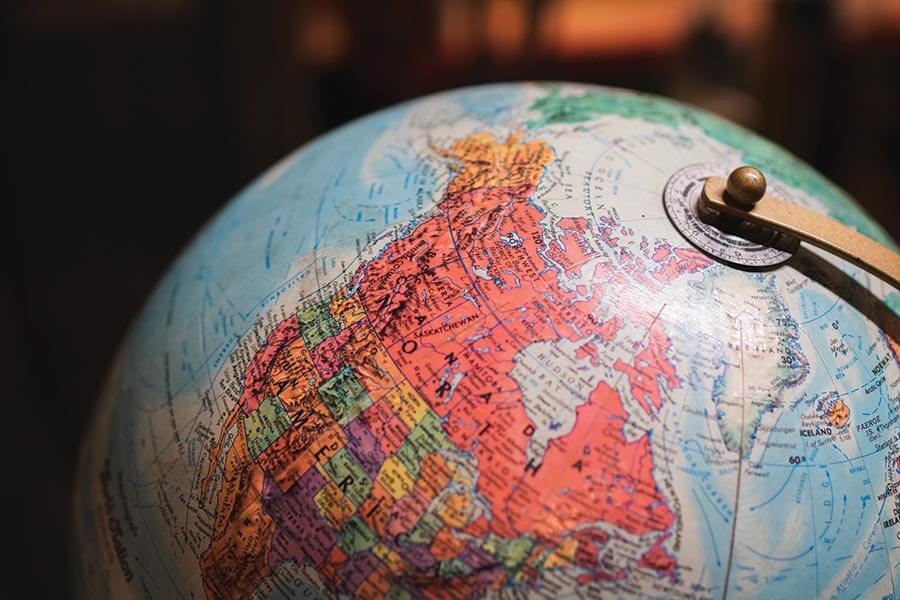
Robert Roberts first visited North America in 1871 in connection with the sad death of John Thomas. He arrived on April 19, and left on July 8, three months less a few days. It must have been a sad time, but perhaps a little uplifting, as he visited twenty-eight ecclesias, and was warmly welcomed by all.
Robert Roberts next visited North America four times in under two years, 1887-88, primarily for purposes associated with the ill-fated sugar project (described below). But he also spent time, particularly in the summer of 1888, visiting ecclesias in the USA and Canada.
His other visits also briefly involved interactions with the Christadelphians in North America, such as a trip across the continent in 1896, and when he called in to San Francisco in September 1898, where he unfortunately died of a heart attack. The first two visits were at a time when he was looking forward to a great financial boost to his efforts to spread the gospel. The last two were in the shadow of a catastrophe.
The two visits in 1896 and 1898 were on his way back to England from Australia. The last being tragically cut short by his death.
We will cover the middle four visits, and the one in 1896. I have described the visit of 1871 before, in The Tidings for March 2021 (p. 24). And the accounts of the events in San Francisco surrounding his death on the morning of September 23, 1898, have been dealt with much elsewhere, including in The Tidings1 so we will pass by this sad event.
1887 Brief Visit
Roberts made a very brief visit in 1887. He arrived on December 4 in New York on the ship “Etruria,” and left on December 10. He was quite coy about the reason: “Having occasion to run over to New York, in connection with the proposed enlargement of The Christadelphian.”
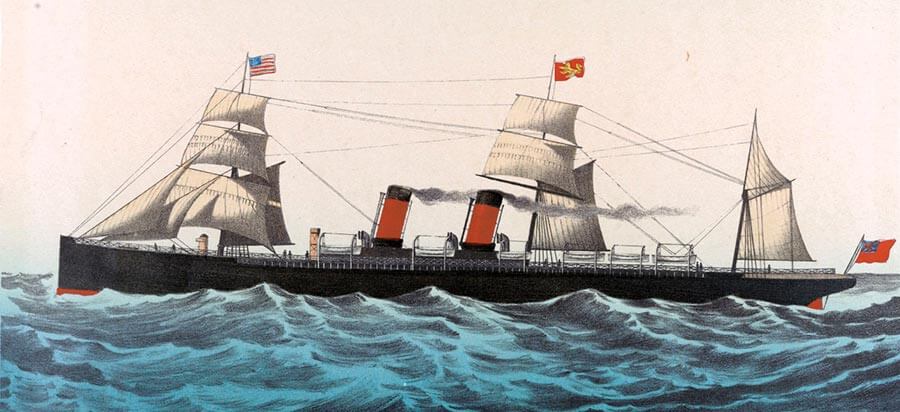
He then described the journey, over the space of almost 12,000 words, but the only evidence of the real purpose is the following paragraph:
His connection with this activity had started via James Robertson, who had been a well-known brother in Liverpool, England, undoubtedly well acquainted with Roberts. According to the various newspaper reports, Mr. Friend came to Liverpool around 1883, looking for funds for his process.
Robertson invested quite heavily, it is said, and in March 1884 he became secretary of the “Electric Sugar Refining Company,” and ultimately received about 1,000 shares of the 10,000 issued. He sold these shares to fund the company, and promoted the company quite heavily, especially among those of his acquaintance in Liverpool. Naturally, Roberts became aware of this, and also promoted the enterprise, apparently quite strongly from 1886.3
In December 1887, after rumors spread that the claims being made were false, Robert Roberts went to verify the process in New York, although he only mentioned the purpose briefly as we described above.
He half-promised a return visit, when he would visit the ecclesias, and this he did six months later.
1888 Sugar—But Also Ecclesial Visits4
He fulfilled his half-promise and made quite an extensive visit, from June to September 1888. He arrived with his wife, Jane, in New York on June 17th at the height of an American summer and was welcomed by Robertson, who we will frequently see in this account. This must have been quite a happy visit. He was with his wife, and he was warmly welcomed everywhere. England and the USA were prosperous, and most of the world was at peace.
The main reason for his visit, the sugar refining company, meant that he thought he was about to receive considerable funds for his magazine, the community, and the colonization of Israel by the Jews. This appeared to be common knowledge, for we find the following quote from a local newspaper of his lecture the following Sunday:
“Money is being gathered in for this future home of the sainted few, both in America and Great Britain. There is likewise a gigantic business undertaking now being projected in this country by one of their leading Liverpool members, Mr. J. U. Robertson, viz.: the Electric Sugar Refining Company, whose offices are at 69, Wall Street, New York, and whose works are being developed at Brooklyn. The wonderful invention whereby sugar can be refined in about two hours from the coarsest brown to the purest crystallized white may be an inspired one likewise, but it is anticipated that the profits will not be less than one hundred per cent. It is being whispered about that a large portion of the profits to be derived from this inspired sugar refinery will be devoted to the building of this temple after the plans of Henry Sully and description of the inspired dreamer, Robert Roberts.”5
By then its promoter, Henry Friend, had died and the subterfuge was carried on by William Howard. It seems clear Robertson had no knowledge of the fraudulent nature of this activity, although he promoted it heavily. It is unknown whether he later lost money in the debacle.
Roberts and his wife then travelled extensively in both Canada and the USA. When he arrived in New York City, he spent two weeks there and then left for a visit to St. John, Newfoundland and Halifax, called in at Boston on the way back to New York City. It appears this excursion was pre-arranged, but when news of his presence spread, he was invited to several ecclesias, including two fraternals. He intended more visits, but the trip was abbreviated because of his fatigue, and he skipped all after Chicago except Lanesville and returned to New York City to recuperate, briefly going to Mahanoy later.
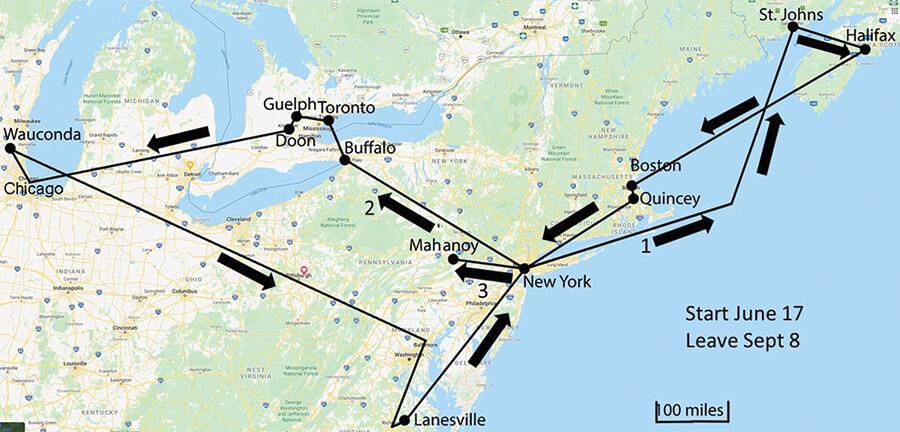
You can see from the map that there were actually two trips after the initial journey North, all beginning and ending in New York City. Unlike in the previous trip in 1871, he included few details of the ecclesial membership on this occasion. It is clear many of the visits were designed to heal the problems that existed in many of the ecclesias, only some being successful.
After his visits, he spent two weeks in New York City further promoting the sugar enterprise. In his notes in The Christadelphian of the time, he strongly objected to the criticisms of this endeavor, “that the absurd and utterly baseless calumnies of those who are eager to ‘take up a reproach against their neighbour’ might be dispelled by the logic of facts,” After all, he had witnessed a (seeming) demonstration of the process.
New York/New Jersey. Robert and Jane Roberts were here on four occasions: at the start and end of their visit, briefly after their first trip, and then again just before their local visit to Mahanoy. When they finally arrived back in the City, they returned to the home of Bro Robertson and apart from sugar activities, attempted to help a split over the strange topic of the use of the lot for selecting a permanent ecclesial leader. A little ecclesia on Staten Island, New York, to which the daughter of John Thomas belonged, was established on that basis. He was apparently successful.
St. John and Halifax. These two isolated ecclesias were established by John Thomas in 1851. It took Robert Roberts two and a half days to get there, another day to get to Halifax, and then he was faced with a 700-mile train journey to Boston, his next ecclesia. Two lectures in St. John were given to reasonable audiences, with an ecclesia of reasonable size, 30-40. Halifax was even more remote, with a tiny ecclesia of nine, reduced by disputations since the times of John Thomas, and a visit of only 24 hours.
Quite why Robert Roberts made the considerable effort to visit these remote ecclesias is unknown, perhaps because St. John was the birthplace of Robertson, who clearly arranged for this visit to North America. (St. John had been a large prosperous ship building city of perhaps 300,000 in 1870, but was beginning its long decline to around 70,000 today, but there are still around 70 members in the area. Halifax was a British garrison city of perhaps 400,000 in 1888. It still is a large city, but only with a few members.)

Boston. This ecclesia, tiny in the early days, had about 75 members this year, which probably made it the largest ecclesia in North America. The Roberts spent a week there, giving the regular Sunday lecture in a low-ceiling hall up three flights of stairs in the heat, and a lecture in nearby Quincy, now simply a suburb of Boston. On July 4, Independence Day, the ecclesia went on an excursion to Worcester with the ecclesia there, about forty miles west, but fatigue made for his absence, not surprising with all the travel. So on to New York City.
Buffalo. This was “only” four hundred miles from New York City, so only a day, and there the Roberts stayed at the home of A. D. (Allen Darius) Strickler, then forty-two, who was to figure in Christadelphian affairs decades later. After a fraternal there and a visit to the nearby Niagara Falls, it was on to Toronto.
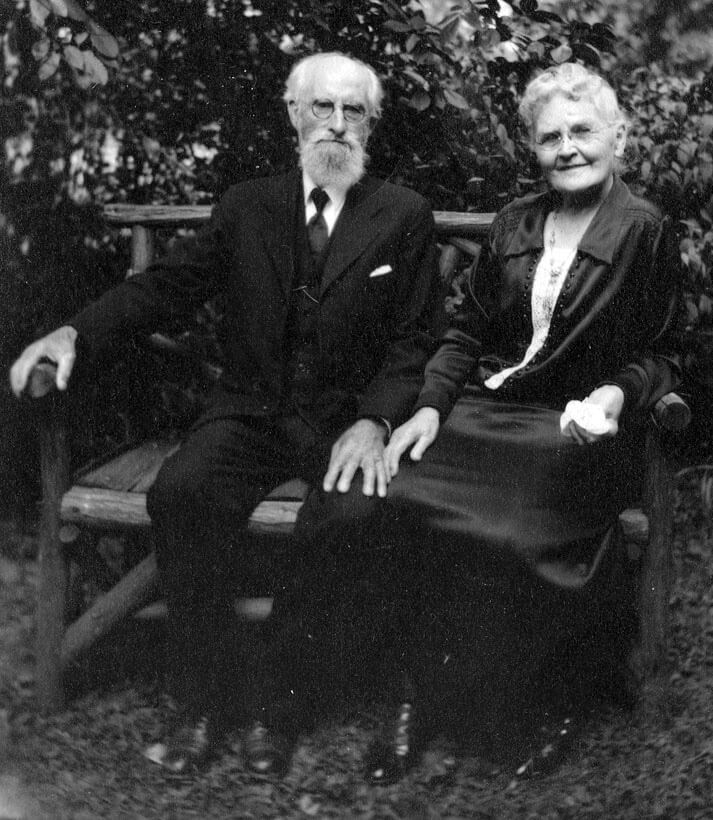
Toronto. This ecclesia had undergone a tumultuous time from its origins about 30 years before and at the time, was split into two ecclesias over the topic of immortal emergence, but the two were persuaded to unite, with very few exceptions so this was a successful visit. (There were about 50-60 Christadelphians in the city.) Then on to Guelph, a mere fifty miles away, an ecclesia which still exists.
Guelph. This was a thriving small town, with an ecclesia that Roberts had visited in 1871, which had at the time about ten members. He delivered two lectures, which were well attended, and enjoyed meeting some he had long known, including one C.H. Evans, who he had met in Birmingham some years ago. So, only twenty-five miles on to Doon.
Doon. This small village, now a suburb of Kitchener, had an ecclesia of 50-60 members out of only about six hundred inhabitants, so it was the largest local congregation. Two lectures, attended by about 200, were delivered and much discussion with the local members was had before departure for one of the two main stops on his travels, a gathering for a week at Wauconda, about 50 miles north-west of Chicago, nearly 600 miles from Doon: 15 hours by rail, an overnight stay in Chicago and arriving at his destination late on Sunday—deliberately so, to avoid having to speak throughout that day.
Wauconda. Situated on the shores of the beautiful local lake, where the area fraternal was held from 1879 until 1891. Robert Ashcroft visited in 1882, shortly before his “Exegetist” magazine started what became known as the “Partial Inspiration” division of 1885. The activities were held from Saturday to Monday, and Roberts had to recover his strength before he could give addresses on Sunday night and Monday night under a tent to an audience of about seventy.
Thomas Williams was one of the main speakers, and he met with Roberts for the first time since he and John Thomas were delivering a series of lectures in 1869 in Mumbles, Wales, just before Williams emigrated. The lecture he delivered, the only one recorded is to be found in The Advocate, October 1888, with a title of “When is Christ Coming?” He starts: “It is not usual for a lecturer to diminish the importance of his subject,” and goes on how it was important to be prepared for the return of Christ at any time. It was an interesting “hook,” as it were. So, on Tuesday, the Roberts were off back to Chicago.
Chicago. The purpose of this visit was to deliver a well-publicized address, and according to the account in the local newspaper, the discussion had to be allowed on his subject, “Christ, the Future King of the World,” and the reports in the newspaper and The Christadelphian both agree that the discussion was antagonistic and prolonged. So, on to Virginia, over 1,000 miles away, which took two days and two nights to cover, and a Sunday in Richmond, where the ecclesial situation had become so uncertain a visit was not suitable.
Lanesville. This week-long gathering, the first of many, was actually held at a church in Lester Manor, which, like Lanesville, has almost disappeared off the map. There were two local ecclesias, which were violently at odds. Both met at the Lanesville Church, but at separate times on Sunday. The problems had been broadcast not only in the magazines but in pamphlets, and this had also caused a rift between Thomas Williams and Robert Roberts. Fortunately, the differences were mostly resolved at this gathering, and Roberts wrote of the agreement at Lanesville:
“This result, and your manifest faithfulness to the truth as a whole, has removed obstacles to co-operation, and made me feel that we can, with advantage to the truth, work together in a common endeavor to uphold the honor and supremacy of the Holy Scriptures in this cloudy and dark day.”
So, Roberts gave several lectures to the throng of almost three hundred. These numbers involved much volunteer effort, for there were no dwellings nearby, so everything had to be improvised.
Mahanoy. After Lanesville, this was the only tour, as the fatigue of Robert Roberts forced the cancelation of all except this almost local visit. At the time, this mining town had around 10,000 inhabitants (now down to only about 1,000), and the Christadelphian Hall is shown on a map of 1889. There were about twenty-five Christadelphians there, a group owing their existence largely due to the work of William Brittle. Roberts struggled through four lectures, and the Roberts returned to New York City and left for home a few weeks later on September 8, after a visit of three months less a week.
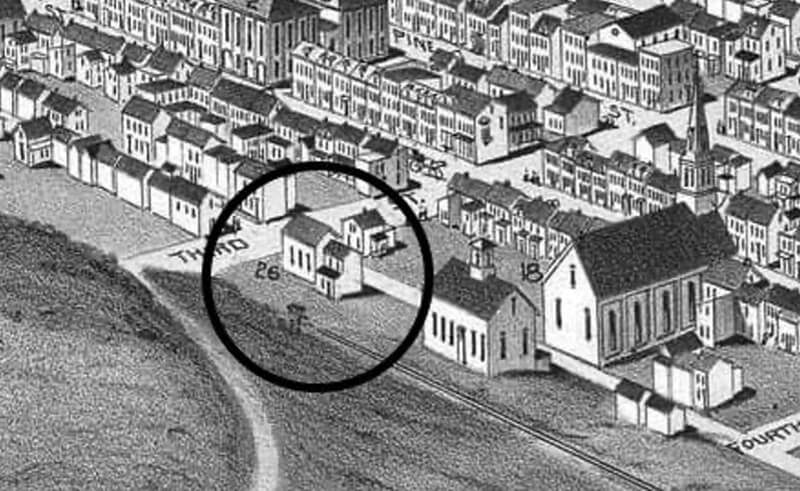
Peter Hemingray
Pittsburgh Ecclesia, PA
Lord willing, this article will be completed in the October edition. It will include the January 1889 unfolding of the sugar disaster and the 1896 return trip from Australia. You can read part two below.
1 The Tidings, 2013, pp 498, 556.
2 The Christadelphian, 1888 p. 41
3 The involvement of Robert Roberts was described, and criticized, in the Fraternal Visitor for Dec. 1886
4 The Christadelphian, 1888, p. 543, 693 is the main source, along with The Advocate for 1888.
5 Quoted in The Christadelphian, 1888, p. 497
ROBERT ROBERTS IN NORTH AMERICA, Part 2
1889 January – Sugar Disaster Unfolds
Bro. Peter Hemingray’s article continues, picking up in 1889, with the “Sugar Disaster.”
It is not the place here to describe details of one of the greatest frauds of the 19th century, which unfortunately greatly affected many Christadelphians. It is covered widely on the Internet.1 The disappointing results are described in The Christadelphian:
“On the morning of Thursday, January 3rd, 1889, I received a cable-message from brother James U. Robertson, of New York, which for a season hurled me into darkness. It was an intimation that a discovery of a ‘terrible’ character had just been made in reference to the sugar refining enterprise, which he had been nursing for four years. The message did not say what the discovery was, but added that there was no doubt of its truth. The message affected me more than any I have received in the course of my life. Every form of prosperity for the work of God upon earth was bound up in the success of that enterprise. The Jewish colonization of the Holy Land was to be helped as no Gentile, and no Jew after the flesh either feels moved to help it. The truth was to be published, both by lecture and literature, as it has never been in this generation. The poor were to be helped as never in our age has been possible. Every grievous load among the brethren, under which private hearts are bleeding, was to be undone. An institution for the annual recuperation of the ailing by a three weeks’ free stay, to which railway fare would be paid to and fro, was to be provided. Other forms of service, not as yet so distinctly defined, were to be entered upon.” 2
There was never any doubt that Roberts was not looking for personal gain, but only for help for the Jews and the gospel.
As soon as he got the cable, he and his wife set out for New York, arriving only to confirm the venture’s complete collapse. They had departed immediately after receiving the cable and, after several misadventures, caught a steamer from Ireland, arriving in New York on Wednesday, Jan 16. They departed on Saturday. There were numerous ramifications, but this is not the place to discuss them.
1889 August
This visit was noted almost in passing in The Christadelphian, in the notes for September 1889, where we read,
“THE EDITOR’S VISIT TO THE STATES. From this the Editor safely returned on Sunday, August 25th, his journey to the States has been sufficient of a success to justify the hope (not yet amounting to certainty) that the losses caused to the brethren by the sugar imposture will ultimately be made good.”
We know a little more from The Advocate, for at the time, Roberts had good relations with the editor, Thomas Williams, and they were together again at the annual gathering in Wauconda. Much later, it was reported that Williams and Roberts met together in harmony, but this was soon to be disrupted, mainly by J. J. Andrews, but that is another story.
“It was on the beautiful lake that skirted the homestead that Thos. Williams and Robert Roberts, seated in a small boat, Roberts in the stern and Williams rowing over its waters the day after the gathering, for three hours discussed the responsibility question in all its bearings and arrived at a good working basis of cooperation.” 3
Robert Roberts disputed this co-operation later when he said, “the result of the conversation was… doubtful.” 4 It was also noted that Roberts was in business with James Robertson, whom he met after the gathering in Chicago and returned to Wauconda to conduct business there, clearly hoping to recoup from his Sugar Disaster.
Unfortunately, the Sugar Disaster was only the start of a series of misadventures he embarked upon, all of which were disastrous and affected his health so gravely that he was advised to take a sea voyage. Others encouraged him to remove himself from such further efforts. So, he decided to accept an invitation and go to Australia, leaving in late August 1895
1896 Back from Australia
Originally scheduled to leave Australia on May 18, he did not leave until June 10, 1896, so his schedule in North America was somewhat pruned. The uncertainty of his actual arrival date caused a rather amusing episode on his arrival in Victoria, B.C. He was summarily deposited on the quay at 4 am, eventually arriving at the house of his host, Thomas Edwards at 7 am. He left his considerable luggage on the doorstep and went for a walk, only to be accosted a little later by his host, somewhat timidly.
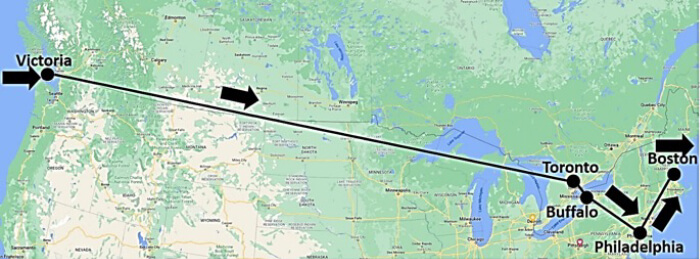
This late arrival also caused some modification to his itinerary, so he only visited the above ecclesias. Of course, it was all just a minor part of his journey back to England, arriving back in England on August 16, having spent two years away from his family.
Victoria. He spent about 11 days in the city, lecturing many times. The ecclesia at the time numbered about twenty as a result of some turmoil caused by recent dissident arrivals from Scotland. But there was some good news: a year later, a correspondent reported he had been baptized after picking a flyer up from the street and attending the lectures.
The “comparatively invalid” set out on the recently completed Canadian transcontinental railroad for five days and nights to Ontario. Changing in North Bay, it was a mere nine hours to Toronto, where he had been a few years before.
 Toronto. Roberts only spent two days there, and no public lectures had been planned, so it was mostly a time for friendly visits. Edwin Hill was his host, who later played a prominent part in Conscientious Objection during WW1. The ecclesial situation in Toronto was complex. There were three ecclesias, one “Central” reported by William Smallwood, which Roberts visited, and others of the Fraternal Visitor and Advocate fellowships. Roberts attempted to unite the first two but with no lasting results. On the other hand, he had a much more pleasant visit to Buffalo.
Toronto. Roberts only spent two days there, and no public lectures had been planned, so it was mostly a time for friendly visits. Edwin Hill was his host, who later played a prominent part in Conscientious Objection during WW1. The ecclesial situation in Toronto was complex. There were three ecclesias, one “Central” reported by William Smallwood, which Roberts visited, and others of the Fraternal Visitor and Advocate fellowships. Roberts attempted to unite the first two but with no lasting results. On the other hand, he had a much more pleasant visit to Buffalo.
Buffalo. Arriving on Friday, July 24, he stayed until the following Thursday, delivering about six lectures and enjoying his time there. Here he again stayed with Bro Stricker. The news in The Christadelphian later said several were still attending after his lectures, so at least a few responded to his message. He left on the Thursday for a lightning visit to Philadelphia, about five hundred miles away, taking 12 hours through pleasant countryside.
Philadelphia. This ecclesia was where James Robertson had settled, but not without attempting further ill-considered ventures, for he was suffering from “failure of business hopes.” He met with the ecclesia (of about 30) on Friday evening, and on Saturday morning, left for the 300-mile trip to Boston, passing through New York City without stopping, due to his appointment in Boston on Saturday night.
Boston. Last stop on his journey: he delivered several lectures during his stay for the week: once such “Preparing for Armageddon” was the subject of a report in the next morning’s paper, and as Roberts said, “The notice was more accurate than usual.” To quote:

“He (Robert Roberts) is a short, thickset man physically, with a large head and a conspicuous face. He has a habit of turning his eyes upward when he’s about making any particularly obscure sentence, and when his statement is likely to be received with doubt he emphatically asserts that there can be no question about it… Mr. Roberts did not make any statement as to the date of Christ’s coming, but he was certain that the visible Christ would come soon, for the disturbed state of the world proved it.” 5
There were about 150 present at the Memorial service on Sunday, including some from the nearby region, so Boston was still probably the largest ecclesia in North America. Roberts also intervened with about fifteen members who were separated over erroneous ideas about unpardonable sin. It was later reported that his efforts were successful. He also attended a social gathering, but under challenging circumstances: a relatively small apartment on a busy street with closed windows, with six fainting in the heat. But he struggled on. He left for England after a stay of 5 days.
Conclusion
Robert Roberts arrived back in England on Saturday, August 16, for a welcome reunion with his wife. He stayed there for almost a year, leaving with his family (less son) for Australia on August 2 next year, planning to remain in Australia but with periodic visits back to England. According to this plan, he left Australia on August 2, 1898, and landed in San Francisco on his way to Victoria on the morning of Sept 21.
He was only fifty-nine when he died, but he had been unwell for some time, burdened by financial catastrophe, efforts for the Truth when ill, as well as the recent news his only son, Edward Augustus, had left the community. He had given structure and vigor to the Christadelphians, traveling much of the world to spread the message from 1864 on. The community had grown from about 1,000 at the time he launched The Christadelphian magazine to over 10,000 when he died.: The community might have been somewhat divided, but all acknowledged his considerable contributions, and messages of grief poured in from all quarters.
And we in North America will be eternally grateful for his work on these shores.6
Peter Hemingray, Pittsburgh Ecclesia, PA
1 This episode had many ramifications, including in Milan, Michigan: a few from that town were sentenced to prison in late 1889. The record of the trial makes interesting reading. Robertson was exonerated.
2 The Christadelphian, 1889, p. 138
3 The Advocate, 1923 p. 95
4 The Christadelphian, 1896, p. 476.
5 The Boston Globe, 3 Aug 1896, p. 10.
6 Engraving from San Francisco Call, Saturday, September 24, 1898.